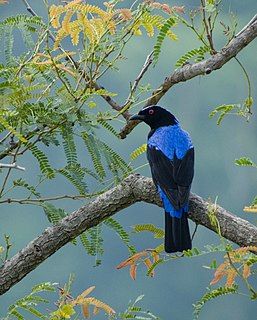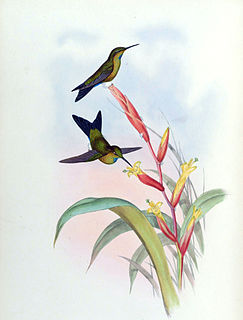| Look up covert in Wiktionary, the free dictionary. |
Covert usually describes events carried out in secrecy.
Contents
Covert may also refer to:
| Look up covert in Wiktionary, the free dictionary. |
Covert usually describes events carried out in secrecy.
Covert may also refer to:
| This disambiguation page lists articles associated with the title Covert. If an internal link led you here, you may wish to change the link to point directly to the intended article. |

Peafowl is a common name for three bird species in the genera Pavo and Afropavo of the family Phasianidae, the pheasants and their allies. Male peafowl are referred to as peacocks, and female peafowl as peahens, though peafowl of either sex are often referred to colloquially as "peacocks".

The Indian vulture is an Old World vulture native to India, Pakistan and Nepal. It has been listed as Critically Endangered on the IUCN Red List since 2002, as the population severely declined. Indian vultures died of kidney failure caused by diclofenac poisoning. It breeds mainly on hilly crags in central and peninsular India.

The isabelline wheatear is a small passerine bird that was formerly classed as a member of the thrush family Turdidae, but is now more generally considered to be an Old World flycatcher in the family Muscicapidae. It is a migratory insectivorous bird. Its habitat is steppe and open countryside and it breeds in southern Russia and Central Asia to northern Pakistan, wintering in Africa and northwestern India. It is a very rare vagrant to western Europe.

The Brass Era is an American term for the early period of automotive manufacturing, named for the prominent brass fittings used during this time for such things as lights and radiators. It is generally considered to encompass 1896 through 1915, a time when these vehicles were often referred to as horseless carriages.

The Asian fairy-bluebird is a medium-sized, arboreal passerine bird.

B. V. Covert and Company was a manufacturer of automobiles in Lockport, New York, from 1901 to 1907. The company started as a manufacturer of steam-powered cars, but later switched to gas-powered vehicles. Some Coverts were exported to England as Covert-Jacksons.

Carola's parotia, also known as Queen Carola's six-wired bird-of-paradise or Queen Carola's parotia, is a species of bird-of-paradise.

The turquoise-throated puffleg, also known as Godin's puffleg, is a species of hummingbird from Ecuador. It is mostly green with blue undertail coverts and white powder-puffs of downy feathers on the legs, and the male has a bluish-purple throat patch. It is only known from a few specimens taken in the nineteenth century and its taxonomic position is unclear. The type of habitat in which the type species was recovered has largely disappeared, and recent surveys trying to find this bird have failed. The International Union for Conservation of Nature believes it may be extinct, but there is a possibility that some individuals remain, so the bird has been rated as "critically endangered".

The eastern ground parrot of Australia is one of only five ground-dwelling parrots in the world, the others being its closest relatives, the western ground parrot, the extremely rare night parrot, the somewhat closely related Antipodes parakeet, and the unrelated highly endangered kakapo from New Zealand.

The Bishop's ‘ō‘ō or Molokai ‘ō‘ō is a member of the extinct genus of the ‘ō‘ōs (Moho) within the extinct family Mohoidae. It was previously regarded as member of the Australo-Pacific honeyeaters (Meliphagidae). Lionel Walter Rothschild named it after Charles Reed Bishop, the founder of the Bishop Museum.

The black-capped tanager is one of the many species of Neotropical bird in the family Thraupidae. It lives in mountains of Ecuador, Colombia and Venezuela year-round. This bird can often be found in open landscapes, alone or in pairs, hiding under branches of trees and bushes. Its natural habitats are subtropical or tropical moist montane forests and heavily degraded former forest.

A covert feather or tectrix on a bird is one of a set of feathers, called coverts, which, as the name implies, cover other feathers. The coverts help to smooth airflow over the wings and tail.

Anchiornis is a genus of small, four-winged paravian dinosaur. The genus Anchiornis contains only the type species Anchiornis huxleyi, named for its similarity to modern birds. Anchiornis fossils have been only found in the Tiaojishan Formation of Liaoning, China, in rocks dated to the Late Jurassic, about 160 million years ago. Anchiornis is known from hundreds of specimens, and given the exquisite preservation of some of these fossils, it became the first Mesozoic dinosaur species for which almost the entire life appearance could be determined, and an important source of information on the early evolution of birds. Anchiornis huxleyi translates to "Huxley's near-bird" in Greek.
The Opaline budgerigar mutation is one of approximately 30 mutations affecting the colour or appearance of budgerigars. It is the underlying mutation of the Opaline variety. When combined with the Yellowface II and Clearwing mutations the Rainbow variety is produced.
American(s) may refer to:

Zhenyuanlong is a genus of dromaeosaurid dinosaur from the Yixian Formation of Liaoning, China. It lived during the Aptian age of the early Cretaceous period, approximately 125 million years ago. It is known from a single specimen belonging to the species Zhenyuanlong suni. This type specimen preserved a nearly complete skeleton that contains traces of feathers, including long tail feathers and large wings. In addition to further complicating diversity of Liaoning dromaeosaurids, this specimen provides the first evidence of well-developed pennaceous feathers in a large, non-flying dromaeosaur, raising the question of what function such wings would serve.

The following is a glossary of common English language terms used in the description of birds—warm-blooded vertebrates of the class Aves, characterized by feathers, the ability to fly in all but the approximately 60 extant species of flightless birds, toothless, beakedjaws, the laying of hard-shelled eggs, a high metabolic rate, a four-chambered heart and a strong yet lightweight skeleton.
Feitianius is a bird genus, belonging to the Enantiornithes, that during the Early Cretaceous lived in the area of modern China. A single species has been named in the genus, Feitianius paradisi.
The blue-throated hillstar is a hummingbird found only in a small portion of the southwestern Andes in Ecuador. It was discovered in 2017.